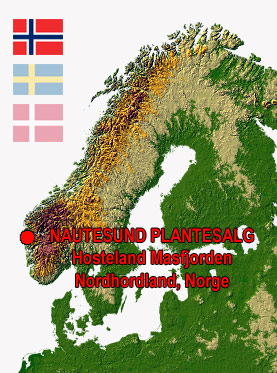 |
||||||||||
NORTHERNMOST FLOWERING EUCALYPTUS: SCANDINAVIAN GUM TREES |
||||||||||
Även de allra härdigaste Eucalyptusarterna är endast marginellt härdiga i de mildaste områdena av södra Sverige. De kommer typiskt överleva i några år för att sedan frysa ner till marken eller dö under en kall vinter. Eftersom många arter är ganska snabbväxande, kan de med lite tur uppnå trädstorlek, blomma och producera frön innan de fryser ihjäl. Den långsiktiga överlevnadschansen kan kanske förbättras om ännu härdigare varianter introduceras eller med lämpligt skydd under vintrarna. Eucalyptusträd har en bättre överlevnadschans i de mildaste områdena av Norge och Danmark. I en del kusttrakter av sydvästra Norge är de härdigaste Eucalyptusarterna förmodligen praktiskt taget fullt härdiga. |
||||||||||
Leif Klingström |
||||||||||
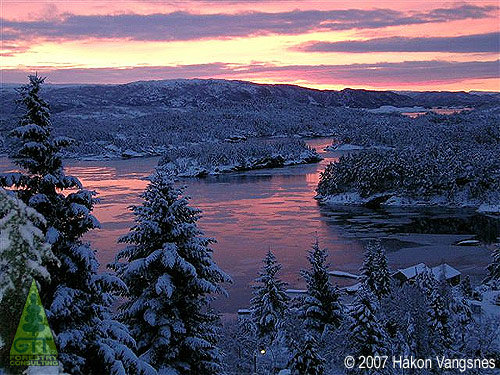 |
|
|||||||||
Winter view from Nautesund, Masfjorden, Hosteland, Norway |
Nautesund location in western Scandinavia |
|||||||||
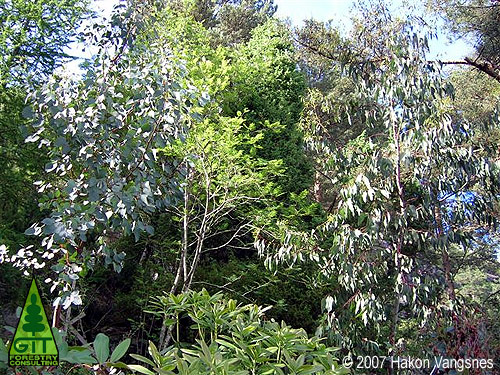 |
At a latitude 61ºN (similar to Anchorage in Alaska, the Southernmost tip of Greenland or the Northernmost tip of Antarctica) in the protected microclimate of Hosteland, at Masfjorden, Norway, we can find one example of successful extreme gardening. In the grounds of Nautesund Plantesalg some eucalypt trees do thrive. Planted by 2002, specimens of Eucalyptus gunnii (Cider Gum tree) and E. dalrympleana (Mountain Gum tree) reach heights of up to eight meters and grow happy enough as to bloom profusely. This feat could easily make them achieve the category of "Northernmost flowering eucalypts in the world". Eighty kilometers to the South of here the nearby city of Bergen, the "Seattle of Europe", receives a yearly average rainfall in excess of 2000 mm (commonly in excess of 2500 mm for up to 250 days per year) and holds records of maximum temperatures as high as 32ºC (1947) and absolute minimum temperatures of -16ºC (1987). The benign influence of the Gulf Stream makes of this area one of the warmest in Norway. Temperatures of the coldest month (January) reach a daily average minimum of -0.5ºC and a daily average maximum of 3.3ºC over a thirty year period. Minimum absolute temperature for 2004 was -7.2ºC. Snow drops are occasional and rarely reach depths beyond 10 cm. At Nautesund yearly rainfall is even higher than at Bergen, and lightly warmer temperatures (minima minimorum -14ºC, extreme yearly minima rarely falling below -10ºC) plus South facing exposure and shelter from polar winds do allow fine examples of "extreme gardening" with exotic plants for such a latitude: from South African Lily hybrids (Agapanthus sp.), Chilean Raulí (Nothofagus alpina) and Monkey Puzzle (Araucaria araucana), through Japanese Aralias (Fatsia japonica) and, Chinese Azaleas (Rhododendron 'Fargesii' and up to other forty cultivars), passing by New Zealand Flax (Phormium tenax), Spear Grass (Aciphylla glaucescens), Toetoe Pampa Grass (Cortaderia sp.) and Giant Dracenas (Cordyline australis), to Himalayean Woody Climbers (Clematis montana). Of course native plants do grow with all the previous exotics, combining sizes, shapes, textures and colours in different spots of the nursery garden. Not surprisingly Tasmanian eucalypts do find this environment happy enough to grow healthy and bloom in due course. But so do Victorian gum trees as Eucalyptus pauciflora ssp. debeuzevillei (Snow Gum tree), which have found their new growing place as interesting as Mt. Hotham. One of the mysteries of growing eucalypts in extreme latitudes far away from those ones in their natural Australian habitats, which is adaption of these normally full sun demanding plants to areas with reduced photoperiods by winter, seems solved. Daylight by winter solstice of 5.52 hours per day (compared to 9.22 hours at 41º latitude by the same time) plus "perpetual rain clouds" do not threaten their survival. These normally non dormant trees might become really sleepy by winter only in these high latitudes, but they are blessed with long and warm summer days (photoperiods of up to 19.22 hours per day) that allow them to keep growing at fast rates. And they prove their satisfaction by spring and summer with welcoming blossoms: Australia and Scandinavia can share some of the ubiquitous Eucalyptus. |
|||||||||
Eucalyptus gunnii (left) and Eucalyptus dalrympleana (right) growing at latitude 61ºN |
||||||||||
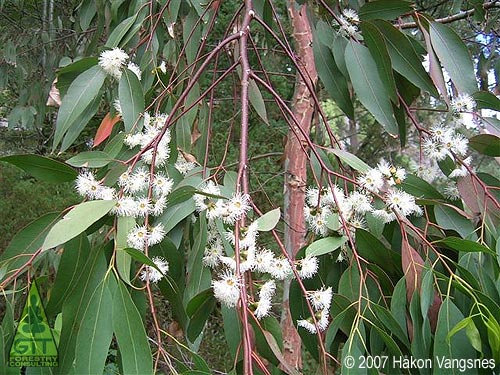 |
||||||||||
Flowering 5 year old Eucalyptus dalrympleana at Nautesund Plantesalg gardens |
||||||||||
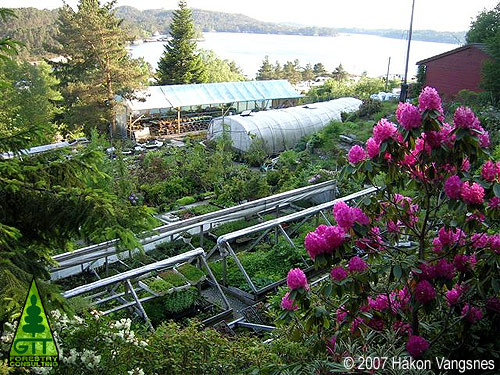 |
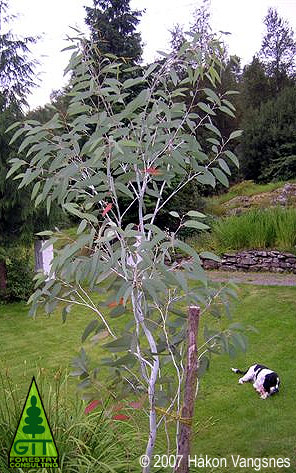 |
|||||||||
A summer view of the picturesque Nautesund Plantesalg (above) and a sleepy Eucalyptus pauciflora ssp. debeuzevillei Snow Gum Tree (right) growing in a garden of the fjords close to the Arctic Polar Circle |
||||||||||
|
|
||||||||||
Special thanks to Håkon Vangsnes. Please visit http://www.nautesund.no/ |
||||||||||
LEIF KLINGSTRÖM'S EUCALYPTUS FÖR SKANDINAVIEN & EXOTISKA DISKUSSIONSFORUM |
||||||||||
SEE SOME COLD HARDY EUCALYPTUS IN IAN BARCLAY'S PACIFIC DESERT NORTHWEST |
||||||||||
 |
||||||||||
© 2007 Gustavo Iglesias Trabado - GIT Forestry Consulting - Consultoría y Servicios de Ingeniería Agroforestal - Acknowledgements - EUCALYPTOLOGICS |
||||||||||
